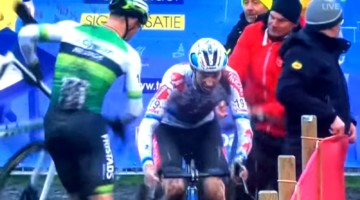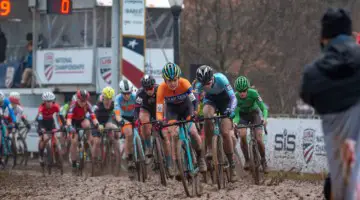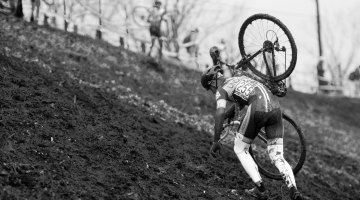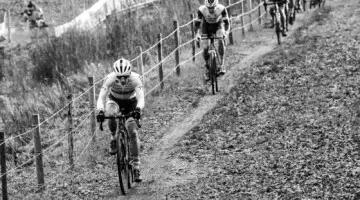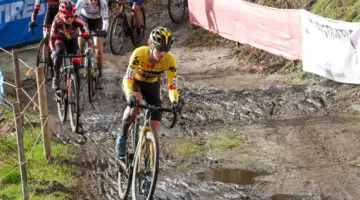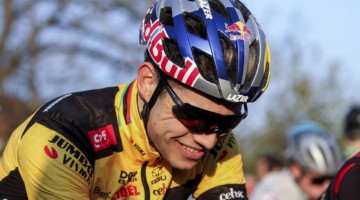Every U.S. Cyclocross Nationals takes a large, dedicated team to pull off. Between managing the venue, getting riders organized, coordinating volunteers and designing and maintaining the course, it takes a village to pull off.
One of the members of the 2019 Lakewood Nationals team is Rich McClung, a cyclist with deep roots in the sport. McClung grew up in Western Wisconsin and went on to race professionally in the late 1980s and early 1990s.
Since retiring from professional road racing, McClung has found his way to the Seattle area where he now serves as co-course designer for the area’s MFG Cyclocross series along with Robert Trombley.
McClung is now bringing his experience and know-how to the Lakewood team as the course designer for the 2019 Nationals course. He set out some of the vision for this year’s track and is working with Keegan Schelling to produce the final Championship circuit.
McClung’s friend and former competitor on the bike Chris Romero sat down with McClung to learn more about his story, talk about this year’s Lakewood Nationals course and muse on cyclocross course design theory.
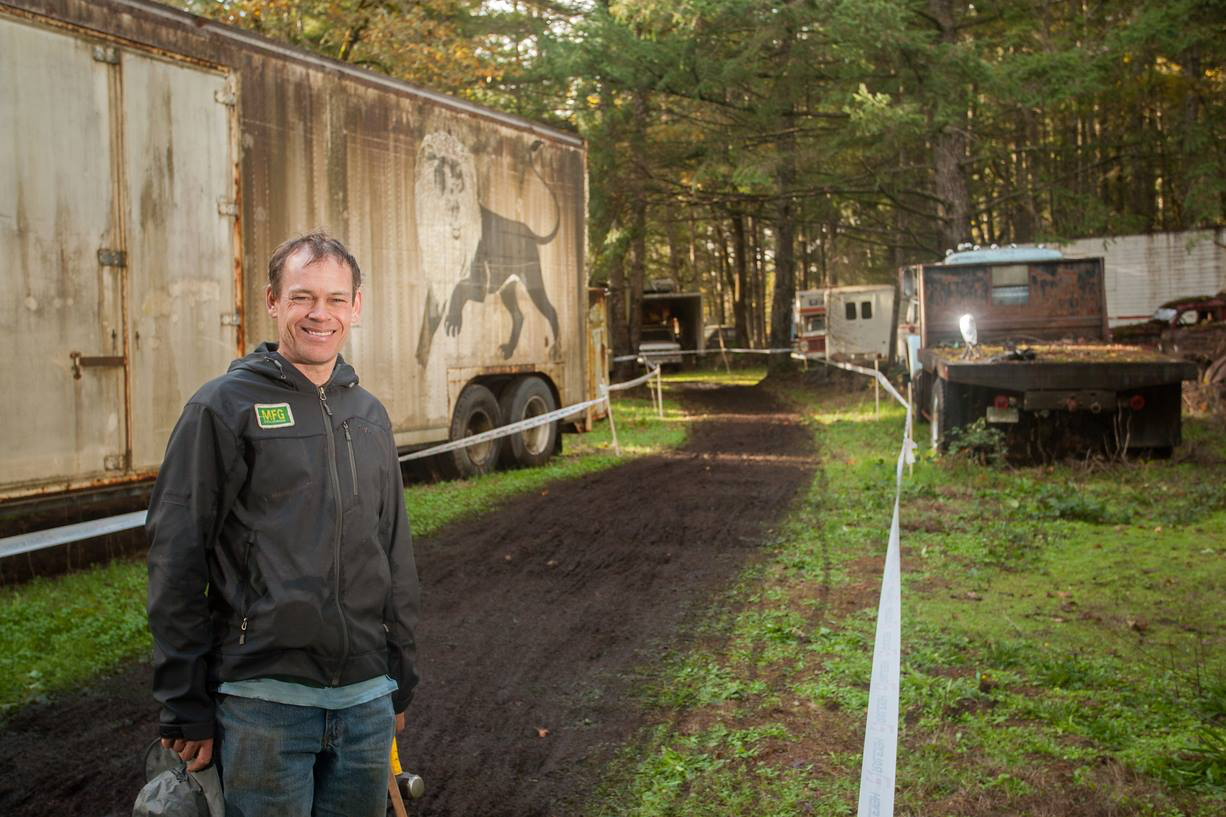
Rich McClung, here at the MFG Lemay venue in 2017, is the Course Designer for this year’s Nationals course. photo: courtesy Rich McClung
You can read a transcript of their conversation below.
Interview: 2019 Lakewood Nationals Course Designer Rich McClung
Chris Romero: Rich, thanks for taking the time to do this. I know you have been pretty busy heading into Nationals.
Rich McClung: You bet. Yeah, the evolution of the Steilacoom course for this year’s Nationals has been fun and a ton of work.
CR: We’ve known each other for a long time. If I’m not mistaken, we met in the Spring of 1989 in Albuquerque, NM riding with Waz (Jim Warsa), Gabe Aragon and your buddy Rick Pepper. We were getting properly schooled in sprint training.
RM: It’s probably Spring of 1988 since that’s when Rick was there. We shared a cheap apartment in town and were both riding on the Paramount CC team out of Santa Ana. I returned to Albuquerque in ‘89, but Rick didn’t make it back…
CR: You’ve had a deep connection to cycling since your teenage years in the fine state of Wisconsin. Is it true that you raised a dairy cow named Jupiter and sold her to purchase your first racing bike?
RM: Yes. Jupiter was the lone Guernsey in our Holstein herd. For working on the farm, our father paid my brother and I in heifer calves. I put Jupiter up for sale after her first calf, but my dad ended up buying her back from me.
Nonetheless, that’s where I got the money to buy my first racing bike—a Paterek frame of Reynolds 531 with Campy Nuovo Record, and Super Champion Medal l’or rims for racing wheels.

U.S. team for the British Milk Race 1990. From left: Chris Carmichael (DS), Steve Larsen, Richard McClung, Scott Fortner, Matt Newberry, Matt Burinda, Jeff Winkler. Lands End England, GB. photo: courtest Rich McClung
CR: Let’s talk a bit about your racing career. You’ve had some incredible results that seemingly started immediately after selling Jupiter.
RM: It actually took me a while to get going racing Juniors in Minnesota. My parents’ farm was in Western Wisconsin about an hour from St. Paul, MN. It was fantastic riding there, but I trained alone all the time. I gradually worked my way through local racing and did pretty well regionally, but my first big break came when I was part of our team that got 2nd at Nationals in the Team Time Trial in 1985. We put an even bigger focus on the TTT the following year. We got 3rd there, even though we went 8 minutes faster.
Prior to that, I managed to win the Lake Front RR at Superweek. My big headline results though are probably my 2nd in the Nationals Individual Time Trial in 1991 and a Bronze Medal in the TTT at the Pan-Am games in Havana. I’ll throw in 2nd in the GC at the Tour of the Gila in 1991 and 5th overall at Redlands in 1987 as honorable mentions.
My biggest wins were undoubtedly winning the Lake Maumelle RR stage of the Natural State Stage Race in Arkansas in 1991 and the Circuito Presidente stage of the Vuelta a Costa Rica in 1989. For the win in Arkansas, I just held off Graham Miller, Dave Mann and Davis Phinney to win from a seven-rider break. The Costa Rica win was just a damn good cagey win. Probably my favorite.
CR: That’s amazing. One can never discount caginess in today’s data-driven wattage obsessed racing and training. When we met you were just about to join Team Shaklee with John Frey, Bart Bowen, Kent Bostick and others on that stellar team.
RM: I was lucky to get a spot there. Two teams I was trying to get a spot on fell through, and I was scrambling to find a ride. I got that spot on Shaklee for just equipment and travel expenses. I was desperately poor that year, but fortunately, I got a lot of rides with the National team in 1989. I did end up riding with Shaklee through 1993 though.

Rich McClung With Roy Knickman at the HOTTER’N HELL 100 Road Race, Witchita Falls, TX 1991. photo: courtesy Rich McClung
CR: Albuquerque was an ironic hotbed of cycling, and there was a culture there that is less known than say, Boulder. Obviously, it was a great place to train year-round.
RM: With Frey, Bostick and Bowen there, and all of the great local guys who had the time and inclination to go out for big rides at just about any time, it was an awesome time to be there; we had a hell of a lot of fun and ate a lot of wind on those roads.
CR: Let’s talk about the upcoming National Cyclocross Championships to be held December 10-15 in Lakewood, Washington. Wait, where is Lakewood?
RM: Lakewood is just south of Tacoma. Fairly close to the Puget Sound.
CR: I am sure this is many years in the works. How many years did it take to make this a reality for Washington?
RM: Terry Buchanan and Zac Daab got together with Dean Burke from the Tacoma and South Sound Sports Commission to put together a bid for Nationals back in 2016. Micah Rice came out to make a site visit shortly after that. The mayor was there with a lot of park and sports commission staff. Together we must have impressed him enough to give us the bid. It really is a great venue and in cooperation with the park, we identified some fun new stuff to carve out of the hillside.
CR: You played a big role in designing the course, correct?
RM: First off, course-wise, it isn’t just me. Robert Trombley and I are a team that put together the MFG cyclocross series courses. Of course, we can both can identify what looks like good terrain for ’cross, but we complement each other in putting courses together. I’m more the overall design guy, getting the pits even and all that, Robert then looks at it from a people management perspective and suggests changes.
We work it out. We send it Terry Buchanan and Zac Daab, and they might have some input. They send it to the property manager and we have a course. When it comes to actually putting the course together, Robert has organizational and deligatory skills I simply do not possess. That’s important because at a couple of our venues we have to set up the course the morning of, and we have to get it done in less than 3 hours.
Normally these days, Keegan Schelling does all the course design for Nationals, but in this case, when we got the bid we had already shown Micah Rice a proposed route. The park staff gave us permission to cut the lines in and those became fixed spots for the course. There weren’t a whole lot of options at that point to design a course other than what we had basically shown Micah.
Fort Steilacoom Park is basically a flat area with a tree and blackberry covered hillside to the west. Keegan is the director of the course and will decide the details, like how the corners and curves in the open areas are staked.
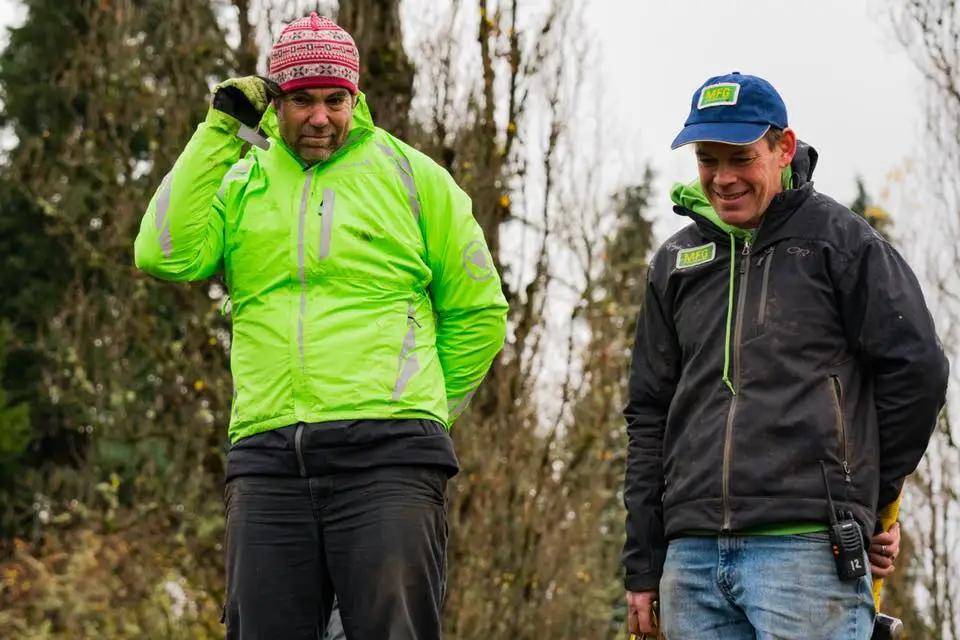
Robert Trombley and Rich McClung take in the action at the 2018 WA state championships, Fort Steilacoom Park, Lakewood WA. photo: courtesy Rich McClung
CR: It’s definitely a passion project. Not that getting street permits isn’t. But it takes both vision and tenacious hard work to really nail a National-level Cross venue.
RM: I basically walked along the hillside and identified areas where there was enough space between trees or more blackberry and scotch broom than trees. There was also some evolution from my original design. When we cut in what is now descent one, Robert looked around and said, “Y’know, we could put in a run-up right next to this descent if we turn the runout for the descent over there.”
Including that totally changed the layout, so I went back to Google Earth, made a few assumptions about what the park staff would let us do and came back with a new course. The park, however, nixed one idea I had, so it was back to the drawing board again. This is where what will now be run-up one and pro-line one came in. Originally run-up one would have turned into what is now the bottom of the pro-line one and continued back down the hill. Instead, we now run all the way to the top and work our way down to descent one.
Cutting in all these lanes has been a tremendous amount of work. Fortunately, we’ve had a very dedicated crew of volunteers from the ’cross community here who have helped Robert and me groom the sections and keep beating the blackberry back. We couldn’t have finished all this in time without them. Pro line two alone took about 10 hours of pulling an especially tough variety of ivy out.
CR: I am sure of that. I imagine envisioning the challenges and suffering that the course dishes out is somewhat, well, enjoyable!
RM: Hah, well, I don’t design courses thinking of inflicting punishment. I just hope that our courses just make for good bike racing. I think the new Steilacoom course is very well balanced and physically demanding. It’s an unusual mix of very fast ground and elevation with technical spots interspersed.
Riding it, I really feel like it’s fast to one feature and before you know it, you’re on to the next one. It just keeps rolling like that. The first part of the last 400 meters is a real kick in the pants … or maybe the face.
CR: Any Beta you can offer as a crib-sheet for competitors?
RM: The key piece of intelligence for the course that you might not pick up from a video or maybe even from taking a lap or two is the ground there is very firm and sand-based, so it drains very well. Even if it rains heavily, the course stays fast. The only place I think that has potential to get seriously muddy is run-up one, but I don’t think it will. Besides the potential tactical considerations that brings, what this means is that if you’re coming with one bike, you’ll be able to finish on that bike barring any major mechanical catastrophe. You’re not going to have to stop or get bogged down because your bike is clogged up with mud.
CR: That is great insight. Especially if you are not traveling with a whole support team. What about the weather?
RM: The weather used to be very predictable here. Just 10-years ago we could count on 40-50 degrees and misty rain. Now though, it could be just about anything. We could get the old traditional weather and actually we’ve been getting that lately. It could be warmer and rain more heavily, it could even snow, although that’s unlikely. The sun could even come out, but if it does it will likely be cold, maybe even down to freezing.
Or who knows? Maybe it will be sunny and warm; weather is as weather does. I always say that cyclocross weather is whatever weather there is when there’s a cyclocross race. Let’s hope there are at least some sunny days—you’ll want to take in the fantastic view of Mt. Rainier from the hilltop.
CR: I climbed Rainier many years ago. It’s a beast and incredible to see from a safe distance. As for the weather, I have heard from many that windows of nicer weather are widening annually. The rain has always been a deterrent for me, and yet I am aware that New York City, where I live, gets as much if not more rain these days.
RM: We’ve had four or five years of very dry ’cross seasons where our races were kicking up huge clouds of dust. So far this year though, we’ve had quite a bit of rain except at the races. Although we did have a slick muddy this past weekend at Woodland Park.
Whatever the weather, the way racing has been going domestically for both the Elite Women and Men this year, I think this course is going to produce some great races. I can hardly wait.
CR: Are you racing?
RM: Yes, my old man’s group is the Masters 55-59. It will be my first year in that one.
CR: I am sure it will be a blast. What are some technicalities of the sport that have changed in the last few years? Seems like there are a lot more rideable sections in newer courses than say 10-plus years ago.
RM: Now that there are the UCI rules, any major race won’t have that jungle cross, singletrack element, so what makes a course “hard” is going to come more from how the racers race. I also think that the level of rider has come up as well. Just speaking from our local series, I’ve seen that it takes a pretty severe grade to make a genuine run-up. In years past it didn’t take so much to get people off the bike. Part of that may be equipment improvement too.
CR: Definitely. Training, diet, clothing, data, what about the bikes?
RM: All bikes are pretty amazing these days huh? Through the years since I started racing ’cross regularly in 1997, each bike I’ve gotten has been more amazing than the last. Wheels are way better, and the variety of tires for ’cross isn’t lacking.
Of course, the biggest change in cyclocross bikes has been the addition of disc brakes. Frankly though, I think that’s overblown. Yes, they do stop you better, it certainly is easier to modulate braking with them, but I think I’m doing just fine with my Paul Neo Retros.
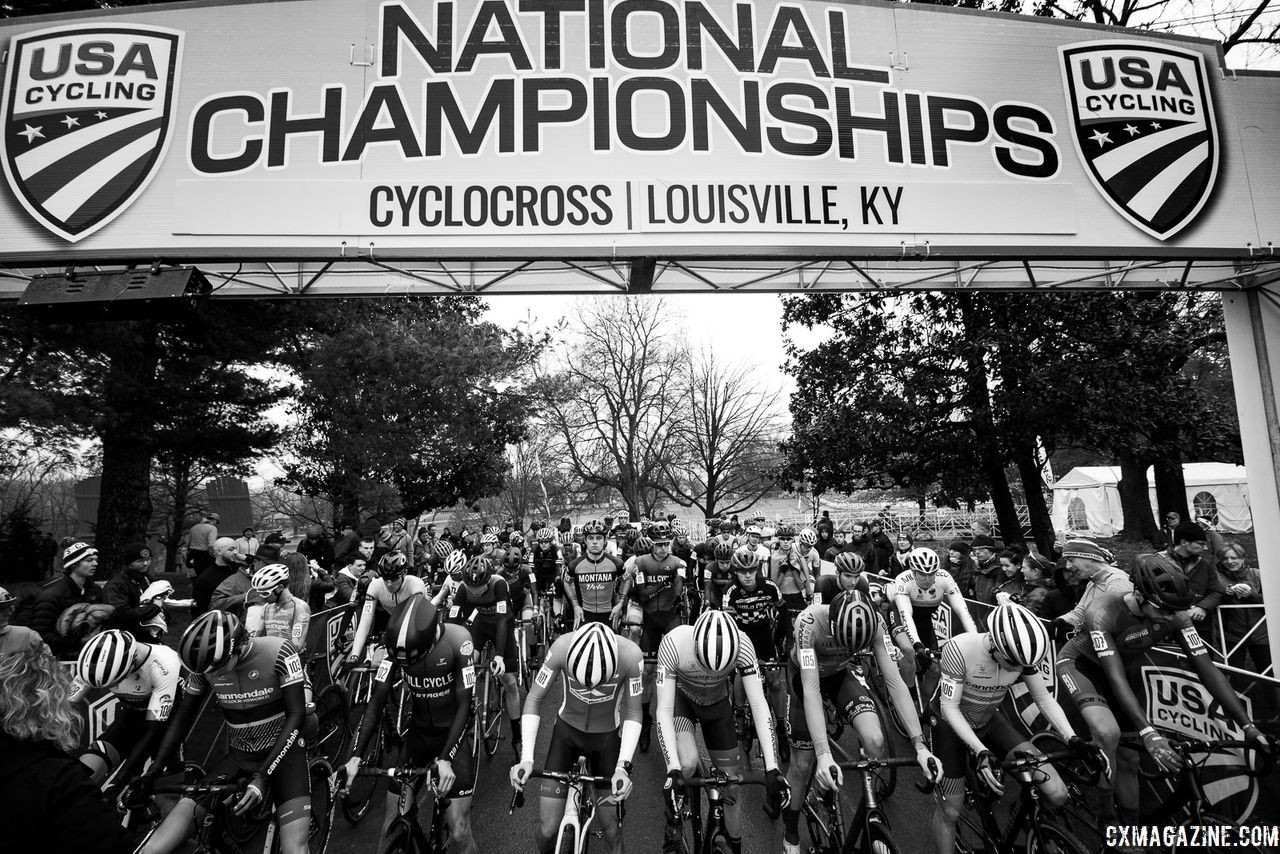
In one week, riders will be gridding up to take on the course McClung helped conceptualize. 2018 Cyclocross National Championships, Louisville, KY. © A. Yee / Cyclocross Magazine
CR: I find the gravel trend pretty interesting. Is it benefiting the cyclocross scene?
RM: Gravel is still pretty new, so I think all other forms of racing benefit gravel more than vice versa. There is Ashton Lambe who went from gravel to the velodrome very successfully, but in general, the gravel scene probably has some maturing to do before you see more riders who started in gravel branching into other forms of racing.
CR: Do you think that road safety is a factor in the rise in the popularity of dirt? Or is it just a lot more accessible and fun?
RM: It is likely both those things and other things too. I think the biggest appeal of ’cross is how compact it is. The races are short, fun and achievable to a wide variety of people, and this happens in the space of a few acres.
Gravel, of course, is a different animal. I’ve only done a few of them, but the main appeal to me is that it takes you places you don’t ordinarily go. We’ve been riding gravel for years and years on 23mm tires, but to make gravel and dirt the main riding surface and make bikes more comfortable for the purpose does widen the world quite a bit. Especially in certain areas like the Plains States which is probably why it really took off there. Here in Washington, you can really get back into some really cool places in the Cascade foothills on dirt and gravel roads.
CR: We will have to see what happens. Between E-Bikes, Gravel and mobility in general, there are a lot of new experiences to be had on two wheels. Having been on two wheels much of your life, is there anything that drives your philosophy around the sport. A mixture between “When I was a kid, dot, dot, dot” and an opportunity to evolve the sport as a founding principle?
RM: Road racing here in Washington is really struggling, and I think it’s a shame. I wish I knew how to fix it, but as you pointed out, there are a lot more choices now, and putting on a good road race is much harder and expensive these days.
’Cross is thriving up here though. I was fortunate to get into it just before it really took off. Terry Buchanan was working with Johnny Sundt on StarCrossed but after a couple of years, Johnny stepped away. I had been fairly vocal at the time about our local races having too much singletrack in them, so Terry more or less asked me to put my money where my mouth was. He wanted to take StarCrossed to a UCI C2, so he asked me to look into the UCI rules and come up with a course. Doing that I learned a lot in a few years in terms of flow and good staking.
A few years later Zac Daab approached Terry about starting what became the MFG Cyclocross series, and I came along with Terry. Zac and Terry do a fantastic job of putting on a great production, and my aim was to bring courses in our local series up to a better standard. Back then we had a time when we were getting more open courses, but then it slipped back to being too much singletrack.
Basically my thought was to try to apply the UCI rules as much as possible for every race. For a local race, it’s rarely 100% possible, but we try. I try to make it so that there are multiple lines and that you can pass everywhere, get the pits in the middle and generally use the land given at the venue to its best purpose.
CR: I like that everyone can pass principle. I remember a Supercup course a hundred years ago that essentially created a “gate-keeper” scenario on a singletrack run-up. On a single lap, a break could be established by simply closing the door. Never seemed right. I mean it was a natural path, but not a great one for fair-play.
RM: I’m a fan of the idea that a course should be as natural as possible; that you should use the land to its best effect. That’s what I’m trying to do. If it’s a hilly venue with a lot of technical character, of course, use it, but spread it out and connect them so it’s fun and challenging. At flat venues, the common temptation is to pepper it with turns, but this usually ends up just making it a braking contest, which many mistake as “technical.”
I say open it up for total speed ’cross. Make the turns so they can be taken fast if you know how to and concentrate them in certain areas and connect them with long fast straights. To anyone who complains it isn’t technical enough, I tell them “All you have to do is go faster, and it gets plenty technical.” A little speed ’cross is good for you.
In designing courses, finding the right balance between technical and pedaling sections in a ’cross course is tricky, and it changes in my opinion with the terrain you have to deal with. I won’t claim we always get it right, but I think we get it most of the time.
CR: If only it was that easy—Just go faster. Dig deeper. Just win! On the East Coast, a big part of our local road races result in massive group finishes. Like the big crits going five-wide into turns. Obviously you don’t want to create those kinds of course experiences.
RM: Well, that scenario isn’t really possible in cyclocross. I despise the term “grass crit.” I can’t see it as anything other than denigratory term, to suggest that a flat, fast ’cross race is of less value than, say, a muddy one.
As someone who has raced for over 35 years now, every race is a matter of figuring out how you’re going to try to win it (or at least be competitive in it), regardless of the course, the weather or whatever. There’s a big variety of landscapes and styles so you’d better be prepared to deal with them all.
I tell you what, as soon as we have a ’cross race that ends with the entire field coming to the line for a field sprint and there are a bunch of crashes because guys who haven’t put their noses in the wind all day are pushing into holes that aren’t there, I’ll concede we have a grass crit.
CR: Well, I am looking forward to flying out for the event and hope to catch the Masters 55-59 race to give you a shout. Gonna need “more cowbell”. Thanks for sharing Rich.
RM: Dynamite, thanks.























